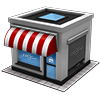18. Daily Usage - General
One of the great things about Checkout is that the way it is setup and designed allows for a fast workflow. There should be very little training required to get somebody up and running in a store. Everything is designed so that it is right there in front of you, and with a click of a few buttons, you can go from creating purchase orders to receiving payments on an invoice to entering new customers.
18.1 Great Features
As with most applications, shortcuts are your friends. Take some time to learn these shortcuts and you may never need to touch your mouse to enter orders or receive payments. The system also implements a live spotlight search that seeks out whatever you are typing as you are typing. If you want to find an order that you know included a specific product, key in that product name or code, and as you’re typing, the system will seek out all orders with that product on it. A fast, simple to use tool that helps you to run your store more efficiently.
18.2 The Main Screen
When you open your store, the main screen is split. The left side of your screen will show a listing of quotes and orders or invoices. You can filter them with the search bar or you can sort them by order number, customer name and even the notes that were entered on the transactions. The right side of your screen will show you your list of products, and a second tab will show you a list of your customers. Again, these can be filtered through with an easy to use search option. When creating an order or quote, you can either double click or drag on a customer name or item to add it to the transaction.
18.3 The Life-Cycle of Sales and Orders
As with most things, there is a beginning, a middle and an end to the life-cycle of sales. The first step is the creation of a sale. This is done by clicking on the New Sale button at the top of your menu. From there, you can optionally add a customer and a product or products to the it. If you have sufficient stock on-hand, the sale will be go through when you click Checkout. If you are short of stock for a specific product or products, you should convert the sale to be an order. Details on orders, quotes, and sales please see Chapter 19: Managing Orders.
Table of Contents
- Welcome to Checkout
- About this Manual
- The Welcome Screen
- Registering Checkout
- Set Up Your Store
- Managing Your Store
- Managing Your Store - General
- Managing Your Employees
- Managing Your Taxes
- Managing Your Suppliers
- Managing Your Products
- Managing Your Shipping
- Managing Your Templates
- Managing Your Shopify Web Store
- Managing Your Reports
- Managing Your Ledger
- Logging In
- Daily Usage - General
- Daily Usage - Managing Orders
- Daily Usage - Managing Invoices
- Daily Usage - Managing Customers
- Daily Usage - Till Count
- Daily Usage - Printing Labels
- Stock Room
